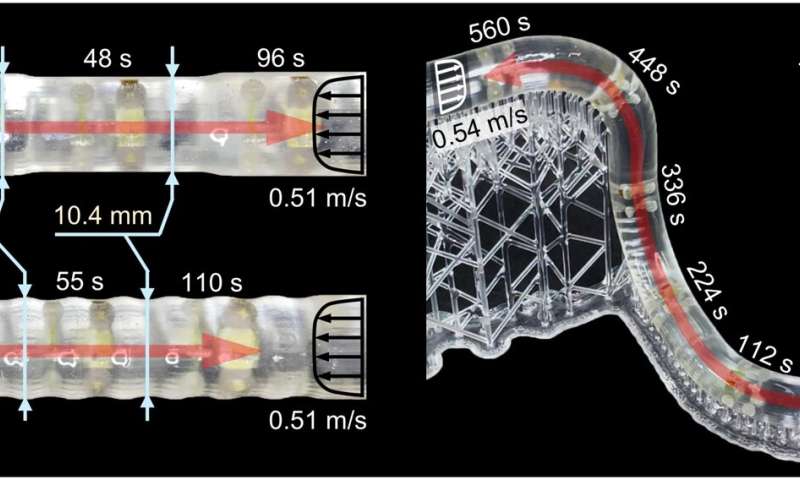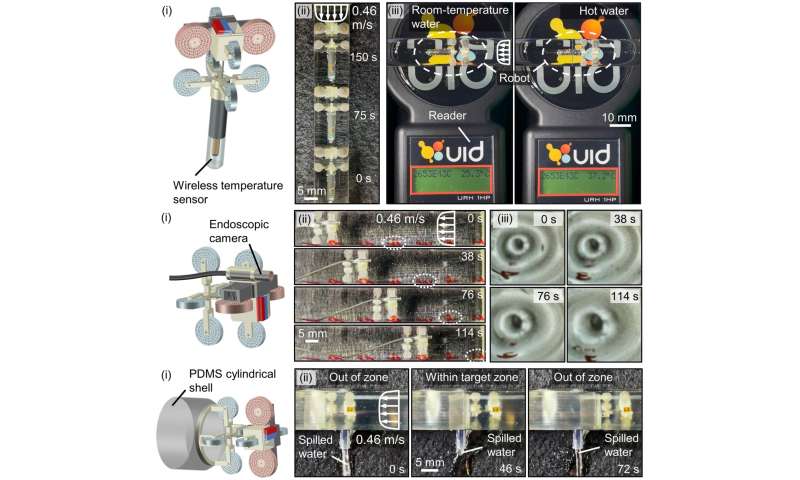
Robots have already proved to be promising instruments to finish complicated and demanding upkeep duties. Whereas engineers have developed a variety of robots that might assist to take care of and restore infrastructure, many of those robots must be plugged into exterior energy sources, which limits their real-world software.
Researchers on the Max Planck Institute for Clever Techniques, Harbin Institute of Expertise, and Hong Kong University of Science and Expertise not too long ago developed a brand new wi-fi miniature robot that may transfer by way of pipes and different tubular constructions with out counting on exterior sources of energy. This robotic, launched in a paper published in Science Robotics, may assist to successfully remedy complicated upkeep issues whereas minimizing injury to pipes.
“Wireless millimeter-scale robots capable of navigating through fluid-flowing tubular structures hold substantial potential for inspection, maintenance or repair use in nuclear, industrial, and medical applications,” Wenqi Hu, co-author of the paper, instructed Tech Xplore. “However, prevalent reliance on external powering constrains their operational range and applicable environments.”
Many beforehand proposed wi-fi upkeep robots are greater than their power-reliant counterparts, can function for a restricted period of time, and have fewer functionalities. Hu and his colleagues got down to develop a wi-fi millirobot that features an inside energy supply and an actuation unit, using its accessible power in a managed means.
This might enable it to cowl longer distances inside tubular constructions and carry out routine upkeep duties for extended durations of time, with out operating out of power.
“Our robot incorporates three key components: a flow-powering module for making use of flow power, a dual-output miniature gearbox for transmitting the converted mechanical energy into the robot’s locomotion system, and kirigami soft wheels for adaptive locomotion in complex tubes,” Hu defined.
“The proposed flow-powered tube millirobot offers controllable up-/downstream long-distance navigation in complex pipelines for diverse applications.”
The wheeled millimeter-scale robotic created by Hu and his collaborators has an inside impeller that may convert the stream of fluids in a tubular construction into mechanical power. Furthermore, the course through which it’s shifting will be modulated just by making use of an exterior magnetic.
“Our robot addresses the needs of applications that demand long-distance navigation, as well as the ability to perform long-duration tasks within confined tubular structures that are filled with flowing gases or liquids,” Hu mentioned.
The researchers evaluated their robotic in a collection of preliminary exams and located that it achieved promising outcomes. As a part of their subsequent research, they plan to additional enhance its capabilities and stability, to facilitate its future deployment in real-world settings.

The robotic’s adaptive locomotion in pipes with altering internal diameter and complicated 3D form. Credit: Chong Hong and Yingdan Wu. 
Credit: Chong Hong and Yingdan Wu.
“Currently, the anchoring force that balances flow resistance acting on the robot’s body is provided by the wheel friction force,” Hu added.
“To make sure secure locomotion in tubes with excessive stream charges (>1 m/s) or low-friction surfaces like oil pipelines, streamlining the robotic physique to reduce stream resistance or including microstructures to the wheel surfaces to extend friction will be efficient.
“In addition, the robot’s motion status switching is limited by the working distance of external magnetic fields. To address this, future robots will be equipped with onboard miniaturized batteries, actuators (such as shape memory alloys), and micro-drive and communication circuits to enable long-distance remote control.”
Extra info:
Chong Hong et al, Wi-fi flow-powered miniature robotic able to traversing tubular constructions, Science Robotics (2024). DOI: 10.1126/scirobotics.adi5155
© 2024 Science X Community
Quotation:
A miniature wi-fi robotic that may successfully transfer by way of tubular constructions (2024, May 1)
retrieved 1 May 2024
from https://techxplore.com/information/2024-04-miniature-wireless-robot-effectively-tubular.html
This doc is topic to copyright. Other than any truthful dealing for the aim of personal examine or analysis, no
half could also be reproduced with out the written permission. The content material is offered for info functions solely.
Click Here To Join Our Telegram Channel
Source link
In case you have any considerations or complaints relating to this text, please tell us and the article will likely be eliminated quickly.








